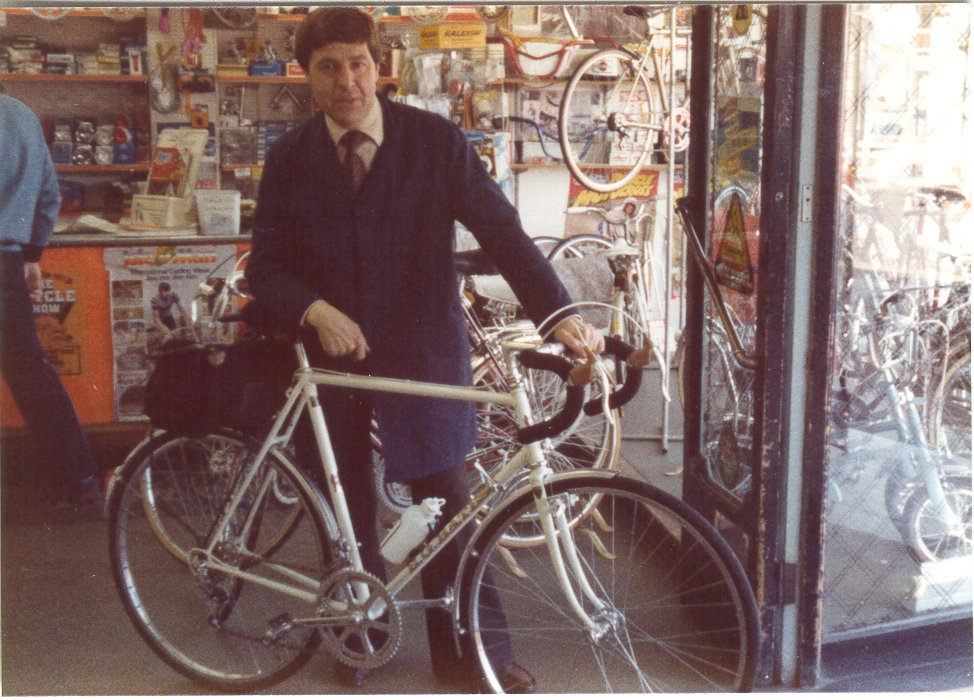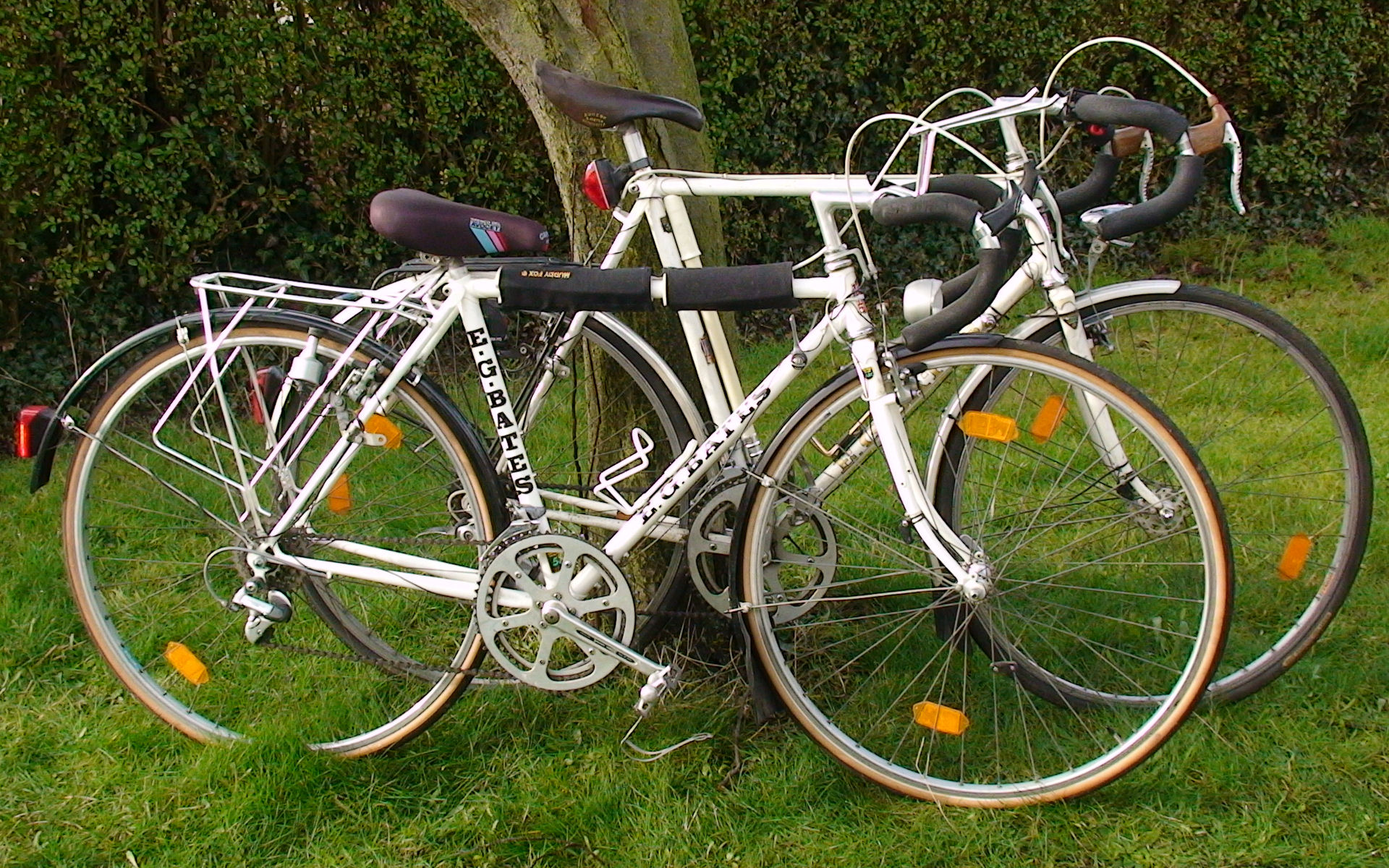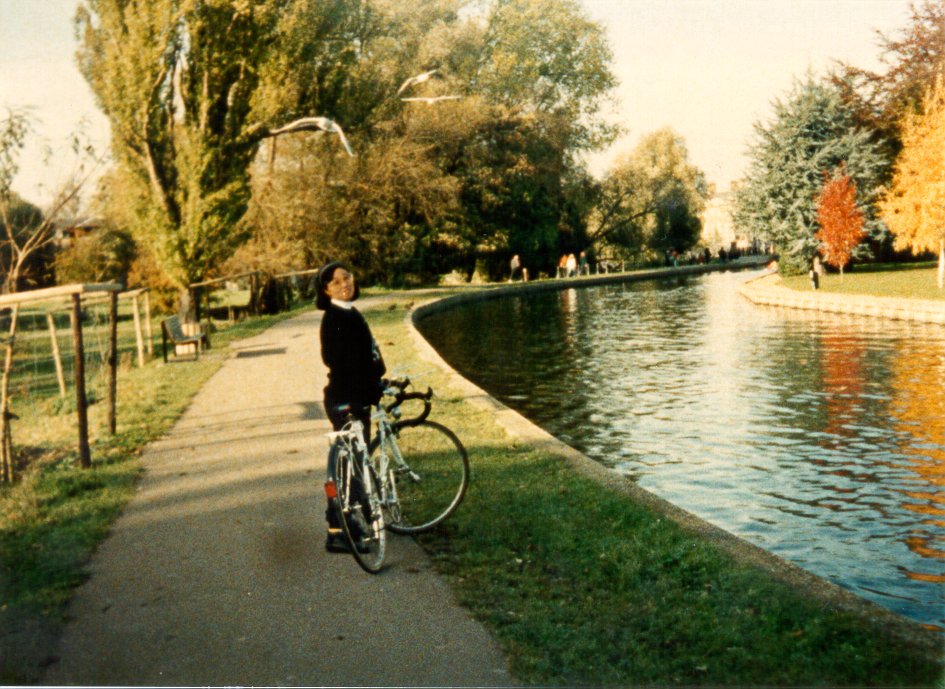
Introduction
Review
Sale Results at
Auction
Links
The racing bicycle is designed for speed
and efficiency. The drop handlebars, lower than the saddle, provide the rider
with an aerodynamic riding posture. The traditional racing bicycle is made with
531 Reynolds tubing and the components made of light weight alloys.
The parallelogram derailleur was introduced in 1937, the Simplex cable shifting
derailleur in 1938, the first modern derailleurm - the Campagnolo Gran Sport -
in 1949, the Suntour slant-parallelogram rear derailleur in 1964 and the
Shimano Index shifting arrived in 1985.
The post war years was a boon time for bicycles. People couldn't afford cars. Many commuter bicycles doubled up as time trial and racing machines with a change of wheels and stripped off mudguards. Every town had a wheelers club and meetings of the CTC (Cyclist Touring Club); of which I am a life time member.
After the second world war Horace and Eddie Bates established a number of bicycle shops in the East end of London. In 1947 Eddie Bates split up from the Bates Brothers and took over the shop at 589-591 Barking Road under the name E.G. Bates. The shop was later run by his sons and remained in business until 2002.
In 1981 I was living in Manor Park, just north of East Ham station, when my Holdsworthy Mistral bicycle was stolen from out side the public library. I had in fact two Mistral bicycles but the second frame took a very long time to be completed and when eventually I got it the geometry was not right. Putney was also much too far away to have to make frequent visits too. So I turned to my local bicycle shop E.G Bates of Flanders House, 589-591 Barking Road, Plaistow, London E13 9EZ.
They built the frame and ordered in the components, fitted the headset and bottom bracket and I assembled the rest.
The completed bicycle is shown below with Mr Bates, the owner of the shop. His father, EG Bates, built the frame in the back room.
The process of determining the dimensions of the frame where important, as well as what would be fitted to it. A well made bicycle, to your dimensions, feels like an extension of you. This is what EG Bates offered.

Before the frame was sprayed I asked if I could see it. I had taken CSE Metalwork and here was the chance to see the work of a master craftsman. Mr Bates had some difficulty persuading his father to let me see it. Apparently it wasn't finished. We looked at, and looked, again, it was perfect. The finish of the bare metal was so good that it looked as if it has been painted that colour. Even the joints needed very close inspection to see the bracing. It is made of Reynolds 531 steel tubing and had Campagnolo ends. No one had every asked to see the frame before it was painted. Another odd request, if not unique, was certainly the first. I have my name stamped on the bottom bracket of the frame, next to the serial number.
I already had a good idea what I wanted from having built recently two Holdsworthy and before that two three other racing bicycles (an all chrome Raleigh, a Carlton and a frame I purchased from a fellow member of the Grantham cycling club). The TA Chain set was on a long waiting list, about 26 weeks. The GB handle bars and stem where hard to find. The Macfac centre pull brakes, Simplex front and rear derailleurs, Campagnolo pedals, head set and hubs. The selection of gears I had worked out by writing a programme in BASIC. The school where I taught mathematics had access to the mainframe at Fords Motor Company in Dagenham via teletype and dial up modem. I developed an algorithm to look for a logarithmic change in gear ratio making it closer at the top gears and larger in the low gears. The 50 and 60 teeth rings where unusually large, as was the long crank.
Even at my fitess, pushing the top gear with 9.2 metres travelled for each turn of the pedals was hard work. The bottom gear with 50 teeth on the front and 30 on the gear block was pedalling like mad to get anywhere, but made going up hills a breeze.
I was never a sporting cyclist, but a commuter. I had discovered that I could cycle the 14 miles to see friends faster than on the 10 miles road race. Moviation, and I had none to race.
Although built for touring, and it was the bicycle I cycled from East Ham to Dover on, it was my daily trip on the North Circular to New Southgate that it was most used.
When I moved to Cambridge and later had work in London I took this bicycle on the train and cycled from Liverpool Street to Farringdon. The plastic of the front derailleur broke, age hardened, a couple of years ago and eventually I found a matching Simplex front derailleur for it - all metal. The fitting is different on more modern bicycles, including the 19" frame with a guide fitted to the bottom bracket. I fitted a rim dynamo and then one to just behind the crank. This had the problem of soaking your shoes in heavy rain. When it gave up I fitted a more efficient rim dynamo. Other than inner tubes and a couple of new tyres it has not needed any other maintenance.
Ten years later (1992), when remarried, I had a second bicycle built. My second Holdsworthy frame was too high for my wife and so a 19.5" frame (the smallest man's bicycle they built) was selected. They had long abandoned making a ladies frame.

I had hoped to move most of the equipment from the Holdsworthy but still had to get different brakes, derailleurs, pedals and seat. The brake levers where particularly difficult to find with a short reach and where obtained separately second hand. The small frame, full size wheels and long crank means that you can catch the toe clips on the front mudguard and the mudguard on the rear wheel is not able to be closely fitted. It would have been better to built totally new from scratch but I saved several hundred pounds on parts and the time that special ordering would mean. I also hoped to get as close a match to my bicycle as I could.
The cross bar still presented a problem and so the brake cable with the braced on loops was padded. The 19.5" bicycle was hardly been used as my wife neglected to inform me that although she used to cycle to work she was uncomfortable in the traffic and wouldn't use it. It now waits for our daughter to be tall enough to use it.

Some years ago I did a revaluation of the bicycles for insurance. Most of the parts are not available so I had to pick appropriate alternatives. The replacement, at that time checked and confirmed by a local bicycle shop, would cost about £1200.
1981 23.5"
1992 19.5"
eBay
http://sheldonbrown.com/bates.html
http://www.classiclightweights.co.uk/builders/bates.html
Last updated 1st February 2010